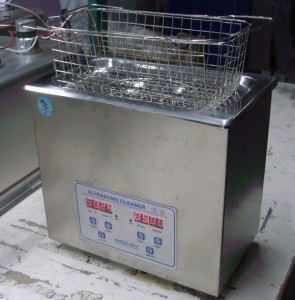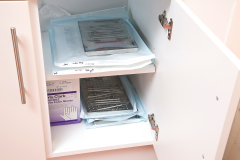Continued from Part 1
Mechanical cleaning with an ultrasonic bath
Ultrasonic baths are an effective method for cleaning intricate, jointed or serrated stainless steel as well as metal instruments and items that are heavily soiled, for example with cement. High-frequency sound waves that create regions of alternating high and low pressure in the bath generates cavitation that is the foundation to how ultrasonic cleaning works. Bubbles form in the detergent under low pressure implode when the pressure changes from low to high, dislodging debris from nooks and crannies of the instruments thus cleaning the surface.
Plastic instruments are not successfully cleaned by this method as they absorb the ultrasonic energy. Remember that ultrasonic bathes only clean and remove microbes; they do not disinfect instruments as the running temperature is below the minimum required to kill even vegetative bacteria.
- The cleaning solutions in ultrasonic cleaners should be changed according to the manufacturer’s use instructions. The cleaning chamber should be decontaminated when the solution is changed.
- Place instruments in the holding container and submerge in the cleaning solution. Load the ultrasonic cleaner with only the recommended number of instruments.
- Cover the ultrasonic bath and process the instruments for the time recommended by the manufacturer (usually 5 to 10 minutes).
- Remove the instrument container and rinse thoroughly under warm water.
- Inspect the instruments and initiate further cleaning if the instruments are still dirty. If hand scrubbing is necessary, scrubbing under warm water is done to reduce creation of splatter, spray and aerosols.
- After rinsing, dry all instruments before packaging for sterilization.
Sterilization of dental instruments
After completion of the decontamination process, dental instruments requiring sterilization should be process by the method of choice dictated by the object or material being sterilized. Heat stable dental instruments shall be cleaned and sterilized before use by using steam sterilization under pressure (autoclaving), dry heat, or chemical vapor. Food and Drug Administration (FDA) cleared the use of chemical sterilants/disinfectants for sterilization of heat-sensitive dental items.
Initiation of sterilization starts with packaging. Dental instruments or containers of dental instruments sterilized by a heat or vapor method shall be packaged or wrapped before sterilization if they are not to be used immediately after being sterilized. These packages or containers shall remain sealed unless the instruments within them are placed onto a setup tray and covered with a moisture impervious barrier on the day the instruments will be used and shall be stored in a manner so as to prevent contamination. Provisions must be made for the contents to be removed without contamination, for example using gloves while handling the items.
Storage and care of sterile dental instruments
The disinfection and sterilization process is of little value unless proper attention is directed to the safekeeping of sterile instruments.
- Storage areas should be dustproof, dry, well-ventilated and easily accessible for routine dental use. Sufficient space in drawers and racks should be available to allow for rotation of bags and packs so that the oldest items through the sterilization cycle are the first used.
- Items must not be stored in any location where they can wet.
- Items should be positioned so that packaged items are not crushed, compressed, bent or punctured.
- Outside shipping containers and corrugated cartons should not be used as containers in sterile storage areas.
- Wrapped sterilized items should be positioned in storage areas so the label and dating entry are readily visible and easily inventoried.
How disinfection and sterilization can fail
Common causes of failure in disinfection and sterilization are:
- Inadequate preparatory steps before the decontamination and sterilization processes are attempted.
- Improper packaging, loading and placement of instruments in the cleaning and sterilization containers.
- Failure to time the period of cycles exposure correctly.
- Lack of attention to the orderly, step-by-step sequence in the operational techniques.
- Failure to understand the limitations, capabilities and requirements of the cleaning and sterilization sequence needed to attain the absolute goal.
- Inadequate attention to details and controls on storage and dating of materials processed in a sterilization cycle.
Consideration for proper sterilization
The following factors should be considered:
- Intelligent, pain-staking efforts and professional discipline.
- Cleanliness of the material’s surface being processed.
- Composition and nature of the item subjected to the procedure.
- Physical and chemical factors in the surrounding environment or medium being treated.
- Time the material is exposed to a disinfection or sterilization agent.
- Shelf life, use life and reuse life of disinfectant.
- Concentration and type of contaminant.
- Concentration and temperature of the solution or gas (chemical agent).
- Steam temperature and pressure.
- An adequate drying cycle.
- A clear understanding and observation of the procedure by the users.
- Rinsing of instruments sterilized by liquid in sterile water.
- Drying of chemically sterilized instruments in sterile towels.
- Proper storage of sterilized instruments.



Nice Blog,where you got lots of informative on this topic.Really Nice one.
Thanks for sharing this information.Keep Sharing more and more.
Thank you for the feedback. Glad to know the article was helpful to you.